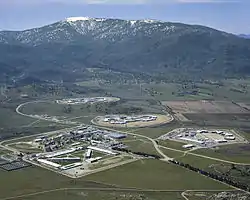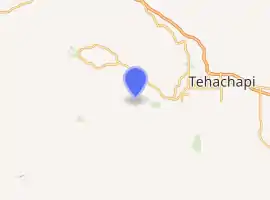California Correctional Institution
California Correctional Institution (CCI) is a supermax state prison located in Cummings Valley, west of the city of Tehachapi in southern California. CCI is sometimes referred to as "Tehachapi prison" or "Tehachapi".[2][3] As stated by the California Department of Corrections and Rehabilitation, its overall mission is "to incarcerate and control felons, while providing the opportunity for meaningful work, training and other programs. The prison provides programs for those inmates who are willing to work and participate fully in available programs."[4]
 | |

| |
| Location | Tehachapi, California |
|---|---|
| Coordinates | 35.111°N 118.569°W |
| Status | Operational |
| Security class | Minimum to Supermax |
| Capacity | 2,783 |
| Population | 2,983 (107.2%) (as of November 30, 2020[1]) |
| Opened | 1954 (original California Institution for Women existed on same site 1932–1952) |
| Managed by | California Department of Corrections and Rehabilitation |
| Warden | Brian Cates |
Facilities

CCI has 1,650 acres (670 ha) including Level I ("Open dormitories with a secure perimeter") housing; Level II ("Open dormitories with secure perimeter fences and armed coverage") housing; Level IV ("Cells, fenced or walled perimeters, electronic security, more staff and armed officers both inside and outside the installation") housing; a Security Housing Unit (SHU, which is "the most secure area within a Level IV prison designed to provide maximum coverage"); and a Reception Center (RC) which "provides short term housing to process, classify and evaluate incoming inmates."[5] As of November 2020, the facility's total population was 2983, or 107.2 percent of its design capacity of 2,783.[6]
History
The original California Institution for Women, the first women's facility in California, opened on the site of what is now CCI in 1932.[7] It was sometimes referred to as "Tehachapi", as in the 1940s films Maltese Falcon and Double Indemnity.[8][9] The institution was "run for many years independently from the correctional system for men" but beginning in 1944 was gradually brought under the control of the California Department of Corrections.[10] After the 1952 Kern County earthquake on July 21, "made the brick dormitories unsafe", the institution was closed and the 417 prisoners were sent to the new California Institution for Women in Corona.[11]
The prison was reopened in 1954 as CCI, an all-men's prison.[5] In 1985–1986, maximum and medium security facilities were added to it.[5] The Southern Maximum Security Complex at Tehachapi was "touted as the most advanced in the country", but was also "called a 'white elephant' and a 'Cadillac' because it took so long to build and cost so much".[12]
Governor Arnold Schwarzenegger "directed inmate firefighters and staff from the California Department of Corrections and Rehabilitation", including those from CCI, to help fight the October 2007 California wildfires.[13]
In popular culture
The women's prison has been frequently mentioned in popular film and radio, particularly during the noir era.
- The Maltese Falcon (1941)
- Double Indemnity (1944)
- Nocturne (1946)
- The Postman Always Rings Twice (1946)
- Out of the Past (1947)
- The Hunted (1948)
- Criss Cross (1949)
- The Story of Molly X (1949)
- 1001 Rabbit Tales (1982)
- The Black Echo, 1991
- Duckman episode title "Noir Gang" (1996)
- Inherent Vice by Thomas Pynchon (page 106 (Italian translation)) (2009)
- Dragnet radio drama series
Notable inmates
- Juan-Carlos Cruz, Celebrity chef sentenced to nine years in 2010 for soliciting murder.
- Barbara Graham, served five years in CCI for perjury, was later executed for murder.
- Blake Leibel
- Lyle Menendez was sent to CCI in September 1996 to serve a life term without the possibility of parole; currently incarcerated at Donovan State Prison.
- Art Pepper, jazz musician, 1964–1965[2]
- Rafael Pérez was transferred from the Los Angeles County Sheriff's Century Regional Detention Facility in Lynwood to CCI in July 2001; later that month he was released from CCI and paroled.[14][15]
- Alonza Thomas Jr, focus of a 2014 PBS Frontline documentary entitled Stickup Kid. Sentenced to 13 years at California Correctional Institution for a crime committed as a 15-year-old juvenile.[16]
- Charles "Andy" Williams
References
- "California Department of Corrections and Rehabilitation: Monthly Report of Population as of Midnight November 30, 2020" (PDF). California Department of Corrections and Rehabilitation, Division of Internal Oversight and Research. November 30, 2020. Archived (PDF) from the original on 2018-03-14. Retrieved December 29, 2020.
- Pepper, Art, and Laurie Pepper. Straight Life: The Story of Art Pepper. Updated ed. New York: Da Capo Press, 1994. ISBN 0-306-80558-8
- Warden Named to State Prison – Official to Take Over Friday in Lancaster. Daily News of Los Angeles, August 25, 1994.
- "California Correctional Institution (CCI)". Ca.gov. Retrieved 26 March 2012.
- California Correctional Institution (CCI) (2009). "Mission Statement". California Department of Corrections and Rehabilitation. Retrieved 17 April 2012.
- Offender Information Services Branch (30 November 2020). "Monthly Report of Population" (PDF). California Department of Corrections and Rehabilitation: 2. Retrieved 29 December 2020. Cite journal requires
|journal=(help) - Bosquet, Jean. Rites open new woman's prison. Los Angeles Times, May 23, 1932.
- Barrett, Larry. Cummings Valley, Tehachapi.
- Dirks, Tim. Review of Double Indemnity (1944). Greatest Films at filmsite.org, accessed Nov 15, 2007.
- Kruttschnitt, Candace, and Rosemary Gartner. Marking Time in the Golden State: Women's Imprisonment in California. New York: Cambridge University Press, 2005. ISBN 0-521-53265-5.
- Tehachapi's inmates will go to Corona. Los Angeles Times, July 24, 1952.
- Mecoy, Laura. "Troubles With Prison Expansion". Sacramento Bee, November 27, 1985.
- "Gov. Schwarzenegger Directs CDCR to Utilize Inmate Fire Crews in Response to Major Wildfires Archived 2007-10-30 at the Wayback Machine". Press release, Oct 22, 2007.
- Former officer moved to prison. Ventura County Star, July 14, 2001.
- Perez Freed From Prison – Parole: Rampart Figure Leaves Tehachapi for Undisclosed Location. Press-Telegram (Long Beach, CA), July 25, 2001.
- "Stickup Kid". Pbs.org. Retrieved 17 August 2018.